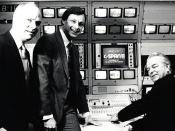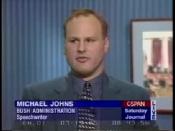C-SPAN, the Cable-Satellite Public Affairs Network is a medium that truly brings the government to the people. By presenting live and uncut footage of our government in action, the citizens of the United States can get a bit closer to what the founding fathers had in mind when they created our government. C-SPAN is truly a unique channel amongst the mass of today's viewing options.
C-SPAN was launched March 19, 1979, 'to provide live, gavel to gavel coverage of the United States House of Representatives.'1, but the enterprise has been expanded beyond the original one channel and now utilizes several mediums to reach its goal. The originator of this idea of bringing government into peoples' homes was Brian Lamb, who in addition to being the chairman and CEO of C-SPAN, is also a host on many of C-SPAN's programs. Brian's primary belief is that people should be able to see government in action without soundbites, computer maps, models, images, music, and news anchor commentary.
Brian feels that if people can see government in action without the normal clutter, then they can more easily make decisions for themselves about politics and the workings of their government. In addition to C-SPAN, a second channel, C-SPAN2 has also been created. C-SPAN2 is committed to providing live and uncut coverage of the U.S. Senate when it is in session. C-SPAN2 continues the tradition of the original channel by giving an even wider unfiltered and unplugged view of our government in action. In addition to video, C-SPAN also has 2 different audio networks that broadcast international and American political content, unfiltered and uncut. Also, C-SPAN has moved into the computer world and has established a homepage to provide information to people about its services, as well as receive feedback from viewers via email.
One of the most unique aspects of C-SPAN is that all of its services are offered totally commercial free. C-SPAN is paid for by cable and satellite operators who each pay a per-subscriber fee to C-SPAN when the channels are carried on their cable systems. C-SPAN does sell merchandise bearing its logo, such as coffee mugs, T-shirts, and hats, however these are certainly intended as advertising for the network itself rather than a direct source of income.
As of July 1995, C-SPAN is received by over 64.3 million or 71 percent of U.S. households, and C-SPAN2 is received by over 41.1 million or 46 percent of U.S. households. C-SPAN is distributed primarily through cable TV systems, however it can also received by both analog and digital satellite receivers. The C-SPAN Audio 1 network is received by 5.1 million households, and 3.2 of these also receive the Audio 2 network.2
When the House is not in session, C-SPAN airs a variety of original programs to round out its 24-7 schedule. 'Washington Journal' is a magazine format morning program that focuses on the events of capital hill. The show features public officials commenting on the morning's news articles as well as a viewer call-in portion in which viewers comment on articles and speak with the guests. 'Booknotes' focuses on in-depth conversations with the authors of recently published books about history, politics, and public policy. 'Road to the White House' was an ongoing series that looked at various aspects of the 1996 presidential campaign including fundraising, debates, advertisements, and party conventions. 'Prime Time Public Affairs' is a program that airs the most important public policy issue of the day. From the President speaking in the White House to a State Department hearing on an important issue, a range of events are covered in their entirety. 'American Perspectives' is labeled as a 'special public affairs program'3 that presents special events and speeches. This program airs only on the weekends. Past programs have included a lecture series on U.S. presidents, a James Carville and William Safire debate, and a look at the Library of Congress' famous Lincoln papers. 'America and the Courts' covers the inner workings of the federal judiciary. This program offers court coverage as well as speeches and appearances by Supreme Court justices. C-SPAN also airs all National Press Club luncheon addresses. Previous speakers have included Bob Dole, Boris Yeltsin, Coretta Scott King, Attorney General Janet Reno, and U.S. Poet Laureate Rita Dove. One of the more novel programs aired on C-SPAN is The Close Up Foundation. In this programs, high school students gather with senior Americans to discuss current events and policy with the nation's leaders. Finally, C-SPAN airs many international programs. Coverage of the British House of Commons Question Time is aired once a week. This provides coverage of the question and answer session between the British Prime Minister and his own party and the opposition party. C-SPAN also airs programming from the legislatures in Japan, Poland, Israel, Germany, and Canada. All of these additional programs are presented, 'to the audience without filtering or otherwise distorting their points of view', and, 'without editing, commentary, or analysis, and with a balanced presentation of points of view.'4
A New Yorker magazine article summed up the C-SPAN experience by this commentary:
'The rest of TV news looks very odd when you come back to it after watching C-SPAN. Rituals long practiced with a great air of authority- the sign-ons, standups, and sign-offs; the drumbeat that attends the announcement of the story of the day; the the gotcha questions that hardly ever get anyone- suddenly look like nervous tics. The whole rhythm of TV news begins to seem jerky and unnatural...'5
One recent innovation of C-SPAN is the C-SPAN school bus. This is a full-sized tour bus that contains a complete video production facility. The bus travels around the country and gathers reports on current event topics. Often, interviews are conducted inside the bus using the small interview set. A second bus has recently been added. For the future, C-SPAN would like to add one, two, or even three more channels. Because its news reporting ability is limited by the erratic hours of the House and Senate, a new channel that has 24 hours free time would be useful. According to the New Yorker article:
'If [Brian] Lamb has his way, there will be a C-SPAN3, a C-SPAN4, and a C-SPAN5 in a few years- networks devoted, respectively, to domestic politics, (political programming apart from the sessions of the Senate and House), to business and economics, and to internatinal affairs. Those ideas, however, are on hold for now, pending the must-carry dispute, and, more importantly, the advent of the 'five-hundred channel universe'.'6
In today's fast paced society, it is difficult to watch more than 30 minutes of traditional television news, and C-SPAN's uncut style is certainly different from anything we normally expect because it does not fit into an average news paradigm. People often complain when the government does things they don't like, but when you agree to let your representatives represent you, you give up a large amount of control over the way the government operates. If one takes the time to watch the coverage that C-SPAN provides, however, it is possible to be just a bit closer to government and regain a bit of control by watching and reacting to the motions of who you've elected to represent you.
Sources
Pamphlet, All About C-SPAN, 1996, pages ii, 1, 6. Received from C-SPAN public
relations department via mail.
C-SPAN Press release, May 1995, pages 2 and 4. Received from C-SPAN public
relations department via mail.
Lardner, James, 'The Anti-Network,' The New Yorker, March 14, 1994, pages 53,
54.
1 Pamphlet, All About C-SPAN, 1996, page 1.
2 C-SPAN Press release, May 1995, pages 2 and 4.
3 Pamphlet, All About C-SPAN, 1996, page 6.
4 Pamphlet, All About C-SPAN, 1996, page ii.
5 Lardner, James, 'The Anti-Network,' The New Yorker, March 14, 1994, page 53.
6 Lardner, James, 'The Anti-Network,' The New Yorker, March 14, 1994, page 54.


